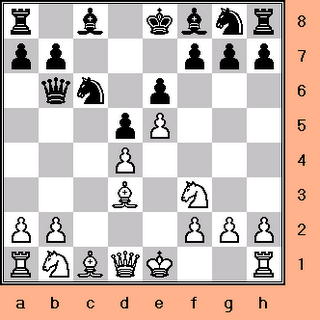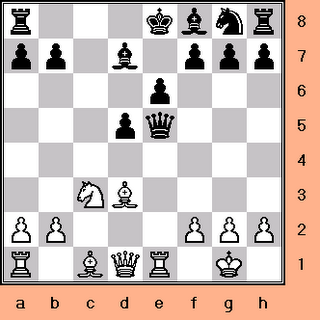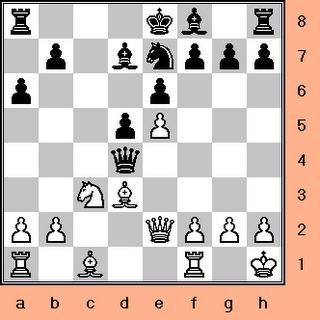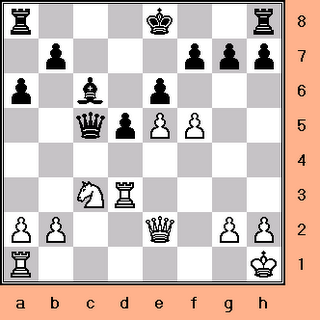Chess: Understanding the French Defense (Milner Barry Gambit) Part I
1 e4 e6 2 d4 d5 3 e5 c5 4 c3 Nc6 5 Nf3 Qb6
6 Bd3 cxd4 7 cxd4 Bd7 8 0-0 Nxd4 9 Nxd4
9 ... Qxd4 10 Nc3 Line

What's the game plan for White?
* Place the bishop on d3 as per move 6.
From d3, the bishop has a clear view
of Black's kingside. In those variations
where Black prematurely castles short,
the typical Bxh7+ combination works
well for White.
* Sacrifice the d4 pawn in return for
attacking opportunities against the
enemy King. This scheme is augmented
by the fact that the Black monarch
often finds it difficult to get to
safety, sometimes even after castling.
What's the game plan for Black?

Accept the proffered pawn as per move
9 and then consolidate the position as
follows:
* Find a safe place for the King.
At times, the queenside may be
the best haven.
* Look for ways to exchange pieces.
With each successful piece trade,
Black's pawn advantage becomes
more telling.
Also available:
Chess: Understanding the French Defense
(King's Indian Attack)
http://chesscoach1950.blogspot.com/2006/04/chess-understanding-french-defense.html
Chess: Understanding the French Defense
(Exchange Variation)
http://chesscoach1950.blogspot.com/2006/08/chess-understanding-french_115663846957406107.html
Chess: Understanding the French Defense
(Steinitz Variation)
http://chesscoach1950.blogspot.com/2006/08/chess-understanding-french_115663318161522094.html
Chess: Understanding the French Defense
(Classical Variation)
http://chesscoach1950.blogspot.com/2006/08/chess-understanding-french_115663144978010132.html
Chess: Understanding the French Defense
(Advance Variation)
http://chesscoach1950.blogspot.com/2006/08/chess-understanding-french_115663038832365852.html
Chess: Understanding the French Defense
http://chesscoach1950.blogspot.com/2006/08/chess-understanding-french-defense_26.html
Chess: Understanding the French Defense
(MacCutcheon Variation)
http://chesscoach1950.blogspot.com/2006/08/chess-understanding-french-defense_25.html
Chess: Understanding the French Defense
(Tarrasch Variation)
http://chesscoach1950.blogspot.com/2006/08/chess-understanding-french-defense.html
Chess: Understanding the French Defense
(Winawer Variation)
http://chesscoach1950.blogspot.com/2006/01/chess-understanding-french-defense_30.html
1 e4

1 ... e6

2 d4

2 ... d5

It's all about controlling the center!
3 e5

3 ... c5

4 c3

4 ... Nc6

5 Nf3

5 ... Qb6

Applying further pressure on d4.
6 Bd3

6 ... cxd4

It's imperative for Black to exchange
on d4 at this particular juncture.
7 cxd4

7 ... Bd7

7 ... Qxd4? would be an error in view of
8 Nxd4 Qxd4 9 Bb5+. After Black responds
to the check, White wins the Black Queen
through 10 Qxd4.
8 0-0

Also playable is 8 Nc3.
8 Be2
8 Bc2
8 ... Nxd4

8 ... Rc8
9 Nxd4

9 Nbd2
9 ... Qxd4

Black is now a pawn ahead.
10 Nc3

White gave up a pawn to gain a developmental lead.
Now Black can choose to accept a second pawn on e5
or decline it and focus promptly on mobilization.
10 Qe2
10 Re1
Variation 1: Black accepts the second pawn on e5
10 ... Qxe5

10 ... Ne7
10 ... Qb6
11 Re1

Developing the rook with gain of tempo.
11 ... Qb8

11 ... Qd6
12 Nxd5

Making use of the pin on the e-pawn.
12 Qf3
12 ... Bd6

13 Qg4

Forcing Black to weaken his King's position.
13 Qh5
13 ... Kf8

Or, 13 ... g6, after which the dark squares
are compromised.
13 ... Bxh2+
14 Bd2

14 ... h5

14 ... f5
15 Qh3

15 ... Bc6

15 ... exd5
16 Ne3

16 Nb4
16 ... Nf6

17 Bc3

Although Black is a pawn up, he has some hurdles
to overcome before his material advantage becomes
telling. His King and Queen are awkwardly placed
and his rooks lack coordination.
17 Nc4
Variation 2: Black declines the e5 pawn.
1 e4 e6 2 d4 d5 3 e5 c5 4 c3 Nc6 5 Nf3 Qb6
6 Bd3 cxd4 7 cxd4 Bd7 8 0-0 Nxd4 9 Nxd4
9 ... Qxd4 10 Nc3

10 ... a6

Guarding the b5 square.
11 Qe2

White is preparing for f2-f4-f5.
11 Kh1
11 Re1
11 ... Ne7

11 ... Rc8
11 ... Qh4
11 ... Qb6
12 Kh1

Unpinning the f2 pawn. Following 12 Rd1,
Black responds with 12 ... Nc6 13 Bxa6
13 ... Qxe5 14 Bxb7 [not 14 Qxe5? Nxe5
15 Bxb7 Rb8 16 Bxd5 exd5 17 Re1 f6
18 f4 Bc5+ 19 Kh1 d4 20 Nb1 Kf7 21 fxe5
21 ... Rhe8] 14 ... Qxe2 15 Nxe2 Rb8.
12 ... Nc6

13 f4

13 ... Nb4

The most expedient approach. Also acceptable is
13 ... Bc5 14 a3 Ba7 15 Bd2 g6, with complications.
14 Rd1

If White tries to retain the bishop by 14 Bb1,
Black can play 14 ... Qc4, followed by d5-d4-d3.
14 ... Nxd3

Although this move is more ambitious than 14 ... Bc5,
Black gets a pleasant game after the latter option:
15 Bxa6 Qf2 16 Qxf2 Bxf2 17 Bb5 Bc6.
15 Rxd3

15 ... Qb6!

Reserving c5 for the f8 bishop.
15 ... Qc4
16 Be3

16 ... Bc5

Since he's a pawn up, Black goes for piece trades.
16 ... Qc7
17 Bxc5

17 ... Qxc5

After closing up the c-file with Bd7-c6,
Black can even consider castling queenside.
18 f5

18 ... Bc6

Not 18 ... 0-0-0 permitting 19 Ne4! dxe4? 20 Rc3.
18 ... Bb5
By ChessCoach@care2.com
6 Bd3 cxd4 7 cxd4 Bd7 8 0-0 Nxd4 9 Nxd4
9 ... Qxd4 10 Nc3 Line

What's the game plan for White?
* Place the bishop on d3 as per move 6.
From d3, the bishop has a clear view
of Black's kingside. In those variations
where Black prematurely castles short,
the typical Bxh7+ combination works
well for White.
* Sacrifice the d4 pawn in return for
attacking opportunities against the
enemy King. This scheme is augmented
by the fact that the Black monarch
often finds it difficult to get to
safety, sometimes even after castling.
What's the game plan for Black?

Accept the proffered pawn as per move
9 and then consolidate the position as
follows:
* Find a safe place for the King.
At times, the queenside may be
the best haven.
* Look for ways to exchange pieces.
With each successful piece trade,
Black's pawn advantage becomes
more telling.
Also available:
Chess: Understanding the French Defense
(King's Indian Attack)
http://chesscoach1950.blogspot.com/2006/04/chess-understanding-french-defense.html
Chess: Understanding the French Defense
(Exchange Variation)
http://chesscoach1950.blogspot.com/2006/08/chess-understanding-french_115663846957406107.html
Chess: Understanding the French Defense
(Steinitz Variation)
http://chesscoach1950.blogspot.com/2006/08/chess-understanding-french_115663318161522094.html
Chess: Understanding the French Defense
(Classical Variation)
http://chesscoach1950.blogspot.com/2006/08/chess-understanding-french_115663144978010132.html
Chess: Understanding the French Defense
(Advance Variation)
http://chesscoach1950.blogspot.com/2006/08/chess-understanding-french_115663038832365852.html
Chess: Understanding the French Defense
http://chesscoach1950.blogspot.com/2006/08/chess-understanding-french-defense_26.html
Chess: Understanding the French Defense
(MacCutcheon Variation)
http://chesscoach1950.blogspot.com/2006/08/chess-understanding-french-defense_25.html
Chess: Understanding the French Defense
(Tarrasch Variation)
http://chesscoach1950.blogspot.com/2006/08/chess-understanding-french-defense.html
Chess: Understanding the French Defense
(Winawer Variation)
http://chesscoach1950.blogspot.com/2006/01/chess-understanding-french-defense_30.html
1 e4

1 ... e6

2 d4

2 ... d5

It's all about controlling the center!
3 e5

3 ... c5

4 c3

4 ... Nc6

5 Nf3

5 ... Qb6

Applying further pressure on d4.
6 Bd3

6 ... cxd4

It's imperative for Black to exchange
on d4 at this particular juncture.
7 cxd4

7 ... Bd7

7 ... Qxd4? would be an error in view of
8 Nxd4 Qxd4 9 Bb5+. After Black responds
to the check, White wins the Black Queen
through 10 Qxd4.
8 0-0

Also playable is 8 Nc3.
8 Be2
8 Bc2
8 ... Nxd4

8 ... Rc8
9 Nxd4

9 Nbd2
9 ... Qxd4

Black is now a pawn ahead.
10 Nc3

White gave up a pawn to gain a developmental lead.
Now Black can choose to accept a second pawn on e5
or decline it and focus promptly on mobilization.
10 Qe2
10 Re1
Variation 1: Black accepts the second pawn on e5
10 ... Qxe5

10 ... Ne7
10 ... Qb6
11 Re1

Developing the rook with gain of tempo.
11 ... Qb8

11 ... Qd6
12 Nxd5

Making use of the pin on the e-pawn.
12 Qf3
12 ... Bd6

13 Qg4

Forcing Black to weaken his King's position.
13 Qh5
13 ... Kf8

Or, 13 ... g6, after which the dark squares
are compromised.
13 ... Bxh2+
14 Bd2

14 ... h5

14 ... f5
15 Qh3

15 ... Bc6

15 ... exd5
16 Ne3

16 Nb4
16 ... Nf6

17 Bc3

Although Black is a pawn up, he has some hurdles
to overcome before his material advantage becomes
telling. His King and Queen are awkwardly placed
and his rooks lack coordination.
17 Nc4
Variation 2: Black declines the e5 pawn.
1 e4 e6 2 d4 d5 3 e5 c5 4 c3 Nc6 5 Nf3 Qb6
6 Bd3 cxd4 7 cxd4 Bd7 8 0-0 Nxd4 9 Nxd4
9 ... Qxd4 10 Nc3

10 ... a6

Guarding the b5 square.
11 Qe2

White is preparing for f2-f4-f5.
11 Kh1
11 Re1
11 ... Ne7

11 ... Rc8
11 ... Qh4
11 ... Qb6
12 Kh1

Unpinning the f2 pawn. Following 12 Rd1,
Black responds with 12 ... Nc6 13 Bxa6
13 ... Qxe5 14 Bxb7 [not 14 Qxe5? Nxe5
15 Bxb7 Rb8 16 Bxd5 exd5 17 Re1 f6
18 f4 Bc5+ 19 Kh1 d4 20 Nb1 Kf7 21 fxe5
21 ... Rhe8] 14 ... Qxe2 15 Nxe2 Rb8.
12 ... Nc6

13 f4

13 ... Nb4

The most expedient approach. Also acceptable is
13 ... Bc5 14 a3 Ba7 15 Bd2 g6, with complications.
14 Rd1

If White tries to retain the bishop by 14 Bb1,
Black can play 14 ... Qc4, followed by d5-d4-d3.
14 ... Nxd3

Although this move is more ambitious than 14 ... Bc5,
Black gets a pleasant game after the latter option:
15 Bxa6 Qf2 16 Qxf2 Bxf2 17 Bb5 Bc6.
15 Rxd3

15 ... Qb6!

Reserving c5 for the f8 bishop.
15 ... Qc4
16 Be3

16 ... Bc5

Since he's a pawn up, Black goes for piece trades.
16 ... Qc7
17 Bxc5

17 ... Qxc5

After closing up the c-file with Bd7-c6,
Black can even consider castling queenside.
18 f5

18 ... Bc6

Not 18 ... 0-0-0 permitting 19 Ne4! dxe4? 20 Rc3.
18 ... Bb5
By ChessCoach@care2.com
3 Comments:
Great stuff, I love this blog!
Thanks for the feedback Bondcoach. It's good to know you're getting some use out of it.
Regarding:
Unpinning the f2 pawn. Following 12 Rd1,
Black responds with 12 ... Nc6 13 Bxa6
13 ... Qxe5 14 Bxb7 [not 14 Qxe5? Nxe5
15 Bxb7 Rb8 16 Bxd5 exd5 17 Re1 f6
18 f4 Bc5+ 19 Kh1 d4 20 Nb1 Kf7 21 fxe5
21 ... Rhe8] 14 ... Qxe2 15 Nxe2 Rb8.
15...Rb8 is inaccurate, white responds with 16. Ba6 and escapes. Black should use instead 15...Ra7! to force 16 Bxd5 exd5.
Post a Comment
<< Home